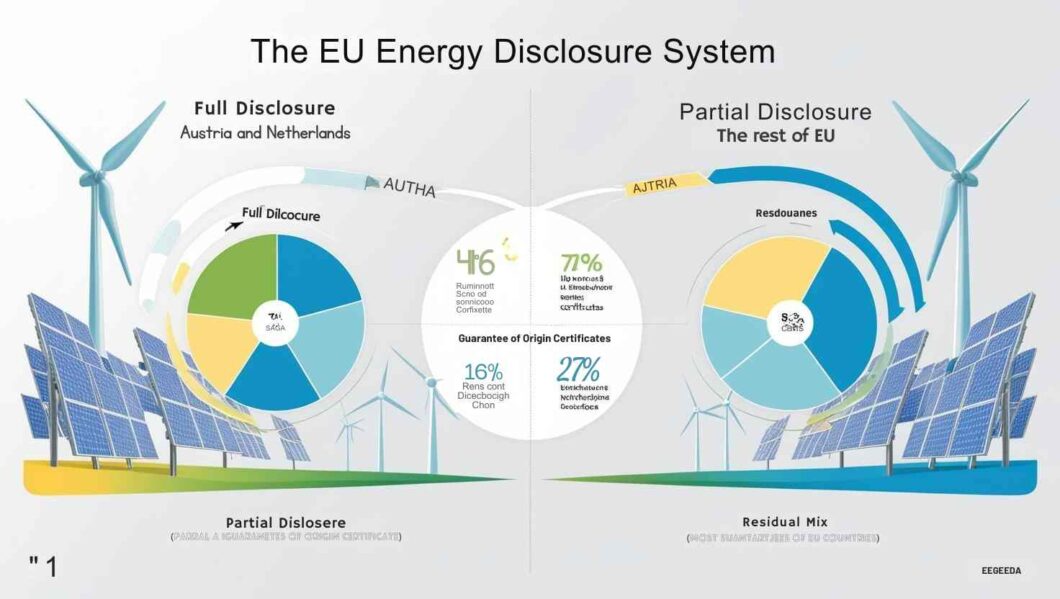The European Union’s energy disclosure framework represents a critical mechanism for driving transparency, consumer choice, and market efficiency in the transition to renewable energy. At its core lies the Guarantees of Origin (GOs) system, which tracks and certifies the renewable source of energy production. While some EU countries have adopted full disclosure models, others maintain partial systems, leading to varied outcomes in market dynamics and sustainability progress.
The Role of Guarantees of Origin
GOs are electronic certificates that verify the renewable origin of electricity, gas, hydrogen, and heating/cooling. Introduced under the Renewable Energy Directive (REDII 2018/2001/EC)47, they enable producers to document each megawatt-hour (MWh) generated from renewables, specifying details like production facility, technology type, and dates. Key features include:
Voluntary participation: Producers decide whether to request GOs, but suppliers marketing “renewable” contracts must use them for proof5.
Market-driven pricing: GO values fluctuate based on demand, incentivizing renewable investments4.
Disclosure compliance: GOs fulfill the EU’s Internal Electricity Markets Directive (2019/944), requiring suppliers to disclose energy sources and environmental impacts to consumers6.
Full vs. Partial Disclosure Systems
Full Production Disclosure (FPD) mandates tracking all energy production (renewable, fossil, and nuclear) with GOs, while Full Consumption Disclosure (FCD) requires suppliers to document every MWh sold with a GO. Countries like Austria and the Netherlands have implemented FCD, but with differing approaches:
Netherlands: Allows GOs to be purchased separately from physical power, fostering competition. Consumers can buy renewable certificates from third parties, maximizing choice37.
Austria: Ties GO cancellations to the physical supplier, limiting consumer flexibility3.
In contrast, partial disclosure systems only mandate GOs for energy explicitly sold as renewable. The remaining “residual mix” (untracked energy) often includes fossil/nuclear sources, reducing transparency6.
Advantages of Full Disclosure
Transparency: Full disclosure eliminates ambiguity about energy sources, empowering consumers to make informed choices36.
Market Catalysis: By decoupling GOs from physical power sales (as in the Netherlands), competition increases, driving down costs and accelerating renewable adoption37.
Compliance with Climate Goals: Tracking all energy production aligns with the EU’s Green Deal and 2050 net-zero targets, enabling precise monitoring of progress37.
Legislative and Policy Framework
REDII (2018/2001/EC): Establishes GOs as the primary tool for renewable certification and mandates member states to implement disclosure systems46.
Energy Efficiency Directive (EED): Expands energy audit obligations for industries and introduces stricter competency requirements for efficiency professionals, complementing disclosure goals2.
Data Center Reporting: The 2024 Delegated Regulation (EU/2024/1364) requires monitoring energy performance and water footprint of large data centers, enhancing sectoral accountability2.
Challenges and Progress
Despite legislative strides, fragmentation persists. The 2025 Competitiveness Progress Report highlights risks to EU clean-tech competitiveness, including supply chain dependencies and lagging innovation1. Full disclosure adoption remains uneven, with some countries resisting due to:
Administrative complexity: Smaller markets may lack infrastructure for comprehensive tracking.
Cost concerns: Higher production costs for EU manufacturers could deter stricter regulations1.
However, the Netherlands’ success demonstrates that well-designed FCD systems can balance market freedom with accountability, offering a blueprint for broader EU harmonization37.
Conclusion
The EU’s disclosure framework is a cornerstone of its energy transition strategy, leveraging GOs to bridge policy and market forces. While full disclosure models maximize transparency and consumer agency, inconsistent implementation across member states creates inefficiencies. Strengthening regulatory alignment and adopting best practices (e.g., decoupling GOs from physical supply) will be critical to achieving the EU’s climate ambitions and maintaining global clean-tech leadership137.
Citations:
- https://energy.ec.europa.eu/news/2025-competitiveness-progress-report-opportunities-boost-eu-clean-tech-2025-02-26_en
- https://energy.ec.europa.eu/topics/energy-efficiency/energy-efficiency-targets-directive-and-rules/energy-efficiency-directive_en
- https://www.ecohz.com/blog/why-full-electricity-disclosure-is-a-good-idea
- https://www.aib-net.org/certification/certificates-supported/renewable-energy-guarantees-origin
- https://www.statkraft.com/newsroom/explained/guarantees-of-origin-ensuring-100-per-cent-renewable-power-in-europe/
- https://www.aib-net.org/certification/uses-certificates/fuel-mix-disclosure
- https://www.ecohz.com/guarantees-of-origin
- https://norsus.no/en/publikasjon/guarantees-of-origin-gos-for-electricity/
